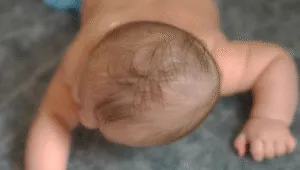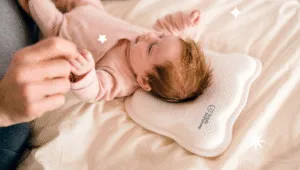Questions about Positional plagiocephaly (pronounced play-jee-oh-seh-fuh-lee) is a condition that affects up to 50% of babies, creating a flattened or misshapen appearance on one side of the infant’s head. This treatable syndrome falls under the umbrella term of cranial deformations and typically develops when a baby’s soft skull becomes asymmetrical due to pressure in a specific position. As a pediatric specialist, I’ve helped countless parents understand that this condition is far from dangerous and responds well to proper care.
Babies are born with soft skull bones that are still developing, making them susceptible to abnormal head shapes when they spend excessive time in one position. The term might sound worrying to new parents’ ears, but this mild to moderate condition affects babies whose heads can take on what some describe as a parallelogram shape when viewed from above. Caregivers often notice their child’s head has a flat spot on the back or side, with the front sometimes appearing more pronounced.
Since health providers began recommending that babies sleep on their backs to reduce SIDS (Sudden Infant Death Syndrome) risks, we’ve seen an increase in positional plagiocephaly cases. This supine sleeping position is essential for preventing sudden death, but it means babies spend a lot of time with the back of their head pushed against firm surfaces. Everything about modern parenting involves different conveniences that keep babies in supine positions, which decreases opportunities for natural head movement.

What Is Plagiocephaly? (Definition & Types)
Understanding the Basic Definition
Plagiocephaly is an umbrella term used to describe different types of skull deformations, including flat head syndrome or positional plagiocephaly. This condition occurs when your baby’s head is misshapen or develops a flat spot, making their head look like a parallelogram from above. Questionsabout positional plagiocephaly usually affect one side of your baby’s head, creating an asymmetrical appearance that parents and caregivers can easily notice.
The condition results from repeated pressure on one part of the head, which causes flattening due to your baby’s soft skull (also called the fontanelle). This might be due to always sleeping in the same position or spending too much time on their back. According to studies, positional plagiocephaly occurs in up to 50% of babies, and it’s usually very mild.
Different Types of Plagiocephaly
Plagiocephaly belongs to an umbrella category of conditions called infant flat head syndrome. These types include:
- Plagiocephaly – flattening on one side
- Brachycephaly – flattening across the back of the head
- Dolichocephaly – elongated head shape
- Craniosynostosis – premature fusion of skull bones
Signs and Symptoms to Look For
Recognizing Early Warning Signs
Questions about positional plagiocephaly. Parents often ask me what symptoms to look for when examining their baby’s head shape. The symptoms of plagiocephaly may vary based on its severity, but you may notice one or more of these signs:
- A head that’s flatter on one side at the back, side, or front
- Less hair on the side of the head that is flat
- Their ear is pushed forward on the side that is flattened
- A misshapen or slanted head
- Their nose is pushed to one side
- Their eyes may look uneven
More Severe Symptoms
Questions about positional plagiocephaly baby with more severe symptoms may also have:
- A forehead, eye, or cheek that is fuller on one side
- An uneven forehead
- Facial asymmetry
- Uneven ear alignment
It’s always best to raise any concerns with your pediatric care team, though mild cases are incredibly common and less severe than many parents initially fear.
Causes and Risk Factors of questions about positional plagiocephaly
Primary Causes of Flat Head Syndrome
Babies’ skulls are soft and somewhat moldable, and infants sleep on their backs for many hours every day. While sleeping, they may consistently turn their head to one side. If your baby sleeps with a turned head too often, the same section of their head may rest on a surface frequently. Regular pressure can flatten that section of your baby’s soft head.
Additional Risk Factors
Questions about positional plagiocephaly. Other factors that increase your baby’s risk for plagiocephaly include:
- Being a twin or multiple birth
- Premature birth – babies born early are more likely to have flattened heads because their skulls are less developed
- Spending extended time in car seats or bouncy seats
- Time spent lying down in the hospital and at home
- Womb positioning during pregnancy

Diagnosis and When to Seek Help
How Healthcare Providers Diagnose Plagiocephaly
You may notice the flattening of your baby’s head by 6 to 8 weeks of age. Your baby’s healthcare provider can diagnose plagiocephaly visually by looking at your baby and observing the flattening of their head. Your child’s provider doesn’t need any tests to confirm or measure flat head syndrome.
Many health providers can help determine the severity and recommend appropriate treatment options during regular check-ups at your pediatric clinic.
Treatment Options and Professional Support
Conservative Treatment Approaches
Questions about positional plagiocephaly. Positional Plagiocephaly treatment starts with changing your baby’s position. You can do this while your baby is asleep or awake. Over time, repositioning shifts pressure more evenly over your baby’s entire head and strengthens their neck muscles.
Physical therapy and repositioning techniques can help address the effects of this condition. A qualified therapist can provide parents with tips and advice on prone positioning during supervised awake time, which helps babies develop strength in different neck positions.
Advanced Treatment Options
Some babies with flat head syndrome also have torticollis (tightened neck muscles). These infants usually need physical therapy and home exercise programs. If the plagiocephaly is severe, your healthcare provider may prescribe a plagiocephaly helmet for your baby.
Many health providers offer guidance on stomach time that reduces pressure on the skull and prevents further flattening during supervised sessions.
Prevention Strategies questions about positional plagiocephaly
Effective Prevention Methods
Some approaches can be used to help prevent plagiocephaly from developing:
- “Tummy time” – short, supervised sessions where your baby lies on their stomach while awake
- Hold your baby wherever possible to reduce the time spent in one position
- Modify your baby’s sleeping position while ensuring they continue to sleep on their back
- Alternating between turning their head to the left and right each time they sleep
- Change the position in which you feed your infant
Faqs
Are There Different Types Of Plagiocephaly?
Yes, plagiocephaly is an umbrella term that includes several types of skull deformations, including positional plagiocephaly, brachycephaly, dolichocephaly, and craniosynostosis.
Do All Babies With Plagiocephaly Also Have Torticollis?
Not all babies with plagiocephaly have torticollis, but the two conditions can occur together. A pediatric therapist can evaluate both conditions.
Does Plagiocephaly Cause Pain Or Discomfort?
Faq about positional Plagiocephaly itself is typically not painful for babies. The condition is primarily cosmetic and doesn’t cause discomfort.
Does Plagiocephaly Affect Brain Development?
Faq about positional Plagiocephaly does not affect brain development or cognitive function. It’s purely a shape issue with the skull.
Is Plagiocephaly Life-Threatening?
No, plagiocephaly is not life-threatening. It’s a treatable cosmetic condition that is far less dangerous than SIDS risks.
How Common is Plagiocephaly?
Plagiocephaly is very common, occurring in up to 50% of babies. Most cases are mild and easy to treat.
What Happens If Plagiocephaly Is Untreated?
If left untreated, plagiocephaly may result in a permanent asymmetrical head shape, though it won’t affect brain function or development.
Will Plagiocephaly Resolve On Its Own?
Mild cases may improve on their own as babies become more mobile, but repositioning techniques and therapy can significantly help reduce the appearance and effects.
When Should I Bring My Baby In For Treatment?
You should consult your healthcare provider if you notice flattening by 6-8 weeks of age or if you have concerns about your baby’s head shape.
How Long Does Treatment Take?
Treatment duration varies depending on severity and the baby’s age when treatment begins. Early intervention typically yields the best results.
Will This Affect My Baby’s Development?
faq about positional Plagiocephaly will not affect your baby’s overall development, brain function, or cognitive abilities. It’s primarily a cosmetic concern.
Managing Expectations and Long-term Outcomes
Questions about positional plagiocephaly therapy approaches focus on encouraging natural head movement while providing caregivers with easy strategies to address this area of concern. While some parents encounter conflicting opinions about treatment approaches, most specialists agree that early intervention through pediatric physical therapy for plagiocephaly positioning methods can significantly reduce the potential for lasting changes.
This makes positional plagiocephaly less of a long-term issue than families might fear when they first notice their baby developing this characteristic appearance. With proper care, advice from health providers, and consistent application of repositioning techniques, most babies show significant improvement in their head shape over time.
CONCLUSIONS
Questions about Positional plagiocephaly is a common and treatable condition that affects many babies but poses no risks to their health or development. Early intervention through repositioning techniques, tummy time, and physical therapy can significantly help reduce the appearance of flat spots and prevent further progression. Parents should work closely with their pediatric healthcare providers to develop an appropriate treatment plan that best suits their baby’s specific needs. With consistent care and proper guidance, most infants with plagiocephaly experience excellent outcomes and normal head shape development over time.
